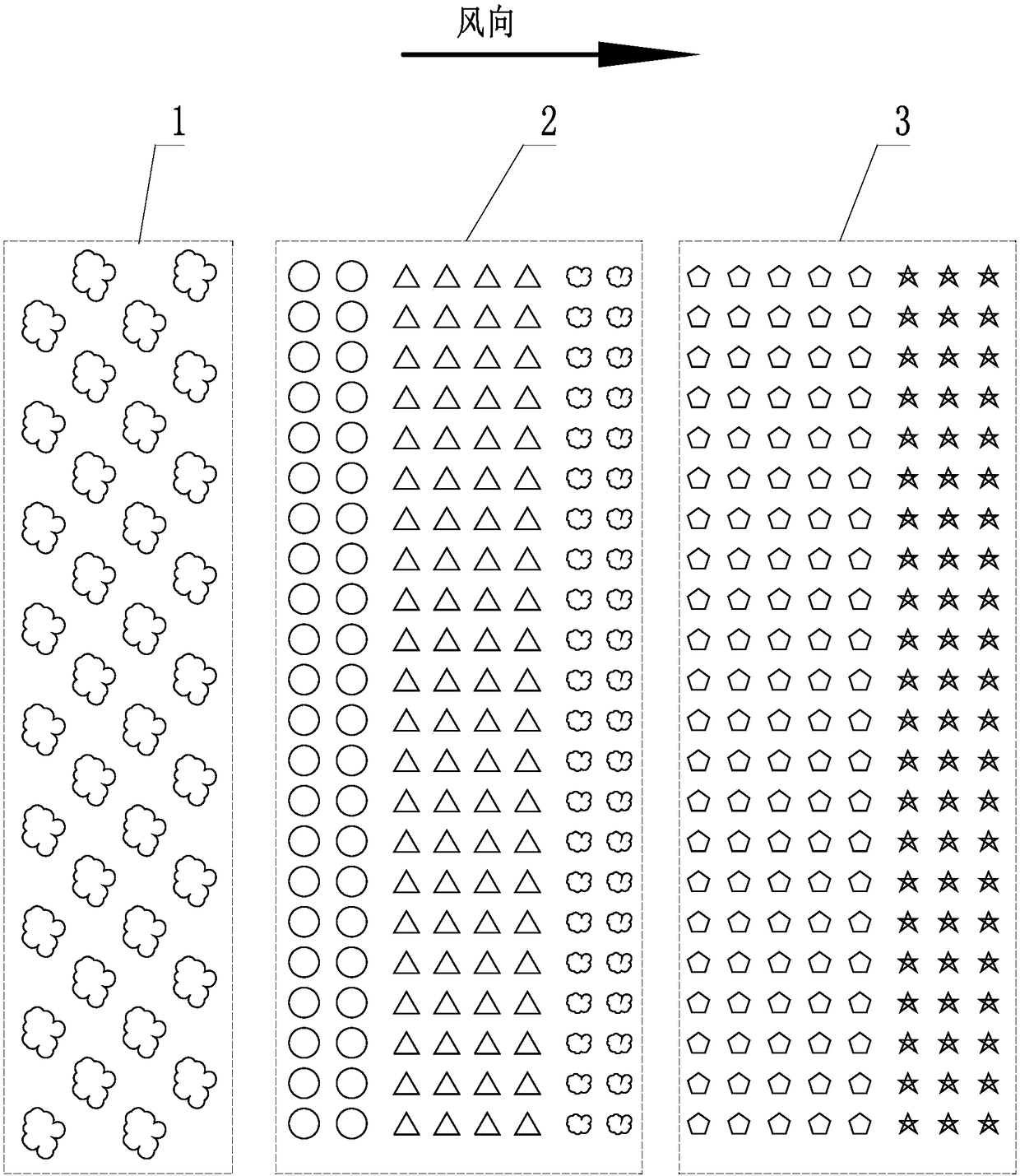Planting method for protection forest in northwest desert area
A planting method and shelterbelt technology, which is applied in the field of shelterbelt planting in the desert area of Northwest China, can solve the problems of high maintenance cost, poor stability, and single planting mode, and achieve low incidence of diseases and insect pests, maintenance of investment in management and protection, and good community stability Effect
- Summary
- Abstract
- Description
- Claims
- Application Information
AI Technical Summary
Problems solved by technology
Method used
Image
Examples
Embodiment 1
[0033] Embodiment 1: mainly comprise the following steps:
[0034] 1) Site selection: choose a wind-sand frontier area without vegetation on the periphery of the oasis, and plant shelterbelts along the main wind direction;
[0035] 2) Plant configuration: The planting time is mid-March in spring, and the arbor, shrub and herbaceous rows are successively planted along the main wind direction from outside to inside, among which:
[0036] The arbor row belt is sorbifolium, with a plant spacing of 1.8m and a row spacing of 3.8m. 4 rows are planted. Three-year-old seedlings are selected and planted in a triangle, that is, plants in adjacent rows are staggered and planted. Fruits can be produced in the second year of planting, generating economic benefit;
[0037] The row belt of shrubs is a mixed strip of willow and Haloxylon, with a plant spacing of 1.3m and a row spacing of 1.8m. Two rows are planted respectively. The distance between the willow belt and the Haloxylon belt is 7m...
Embodiment 2
[0045] Embodiment 2: mainly comprise the following steps:
[0046] 1) Site selection: choose a wind-sand frontier area without vegetation on the periphery of the oasis, and plant shelterbelts along the main wind direction;
[0047] 2) Plant configuration: The planting time is mid-March in spring, and the arbor, shrub and herbaceous rows are successively planted along the main wind direction from outside to inside, among which:
[0048] Arbor row belt is sorbifolium, with a plant spacing of 1.9m and a row spacing of 3.9m. Five rows are planted. Three-year-old seedlings are selected and planted in a triangle, that is, plants in adjacent rows are staggered. benefit;
[0049] The row belt of shrubs is a mixed strip of Ostrich willow and Haloxylon saxaul, the plant spacing is 1.7m, and the row spacing is 1.85m. Two rows are planted respectively. Black-fruited Lycium barbarum is planted between plants, with a plant spacing of 1.05m and a row spacing of 2.15m, which can produce eco...
Embodiment 3
[0057] Embodiment 3: mainly comprise the following steps:
[0058] 1) Site selection: choose a wind-sand frontier area without vegetation on the periphery of the oasis, and plant shelterbelts along the main wind direction;
[0059] 2) Plant configuration: The planting time is mid-March in spring, and the arbor, shrub and herbaceous rows are successively planted along the main wind direction from outside to inside, among which:
[0060] The arbor row belt is sorbifolium, the plant spacing is 2m, the row spacing is 4m, and 6 rows are planted. Three-year-old seedlings are selected and planted in a triangle, that is, the plants in adjacent rows are staggered and planted. Fruits can be produced in the second year after planting, resulting in economic benefits;
[0061] The row belt of shrubs is a mixed strip of willow and Haloxylon, with a plant spacing of 1.35m and a row spacing of 1.9m. Two rows are planted respectively. The distance between the willow belt and the Haloxylon belt...
PUM
 Login to View More
Login to View More Abstract
Description
Claims
Application Information
 Login to View More
Login to View More - R&D
- Intellectual Property
- Life Sciences
- Materials
- Tech Scout
- Unparalleled Data Quality
- Higher Quality Content
- 60% Fewer Hallucinations
Browse by: Latest US Patents, China's latest patents, Technical Efficacy Thesaurus, Application Domain, Technology Topic, Popular Technical Reports.
© 2025 PatSnap. All rights reserved.Legal|Privacy policy|Modern Slavery Act Transparency Statement|Sitemap|About US| Contact US: help@patsnap.com

